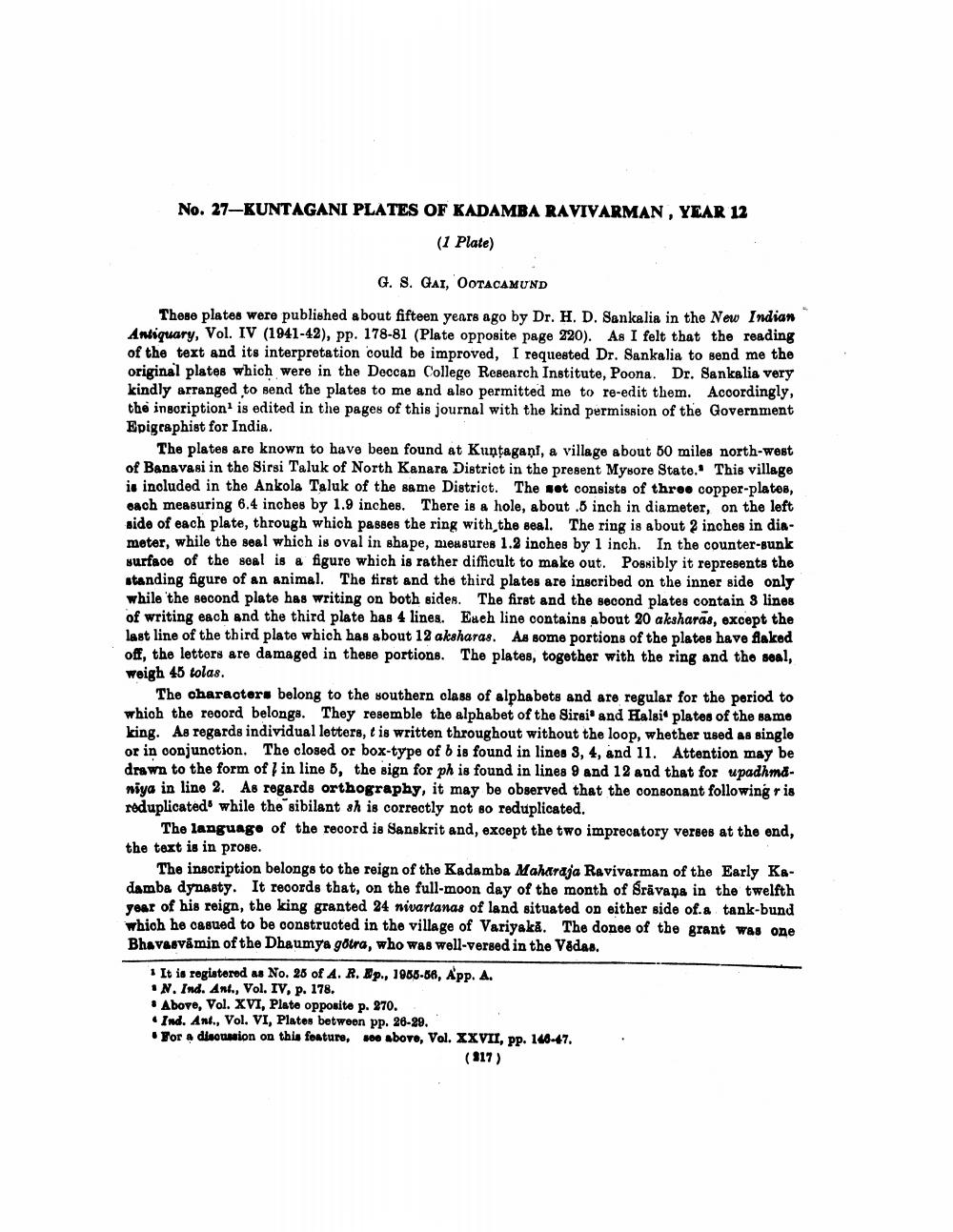________________
No. 27–KUNTAGANI PLATES OF KADAMBA RAVIVARMAN , YEAR 12
(1 Plate)
G. S. GAI, OOTACAMUND
These plates were published about fifteen years ago by Dr. H. D. Sankalia in the New Indian Antiquary, Vol. IV (1941-42), pp. 178-81 (Plate opposite page 220). As I felt that the reading of the text and its interpretation could be improved, I requested Dr. Sankalia to send me the original plates which were in the Doocan College Research Institute, Poona. Dr. Sankalia very kindly arranged to send the plates to me and also permitted me to re-edit them. Accordingly, the insoription is edited in the pages of this journal with the kind permission of the Government Epigraphist for India.
The plates are known to have been found at Kunțagani, a village about 50 miles north-west of Banavasi in the Sirsi Taluk of North Kanara District in the present Mysore State. This village is inoluded in the Ankola Taluk of the same District. The set consists of three copper-platos, oach measuring 6.4 inches by 1.9 inches. There is a hole, about .5 inch in diameter, on the left side of each plate, through which passes the ring with the seal. The ring is about 2 inches in diameter, while the seal which is oval in shape, measures 1.2 inches by 1 inch. In the counter-Bunk surface of the seal is a figure which is rather difficult to make out. Possibly it represents the standing figure of an animal. The first and the third plates are inscribed on the inner side only while the second plate has writing on both sides. The first and the second plates contain 3 lines of writing each and the third plate has 4 lines. Eseh line contains about 20 aksharas, except the last line of the third plate which has about 12 aksharas. As some portions of the plates have flaked off, the letters are damaged in these portions. The plates, together with the ring and the seal, weigh 45 tolas.
The characters belong to the southern class of alphabets and are regular for the period to which the record belongs. They resemble the alphabet of the Sirbi and Halsi plates of the same king. As regards individual letters, t is written throughout without the loop, whether used as single or in conjunction. The closed or box-type of b is found in lines 3, 4, and 11. Attention may be drawn to the form of in line 8, the sign for ph is found in lines 9 and 12 and that for upadhmd. niya in line 2. As regards orthography, it may be observed that the consonant following ris roduplicated' while the sibilant sh is correctly not so reduplicated.
The language of the record is Sanskrit and, except the two imprecatory verses at the end, the text is in prose.
The inscription belongs to the reign of the Kadamba Maharaja Ravivarman of the Early Kadamba dynasty. It records that, on the full-moon day of the month of Srāvana in the twelfth year of his reign, the king granted 24 nivartanas of land situated on either side of.a tank-bund which he casued to be construoted in the village of Variyaka. The donoe of the grant was one Bhavasvåmin of the Dhaumya götra, who was well-versed in the Vedas.
It is rogistered as No. 25 of A. R. Bp., 1966-68, App. A. IN. Ind. Ant., Vol. IV, p. 178. . Above, Vol. XVI, Plato opposite p. 270. . Ind. Ant., Vol. VI, Plates between pp. 26-29. For a diaoussion on this feature, se above, Vol. XXVII, pp. 146-47.
(317)




